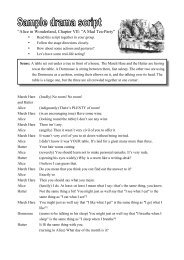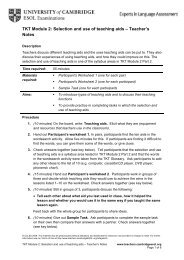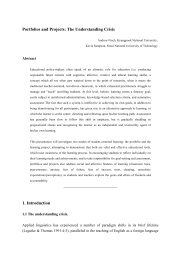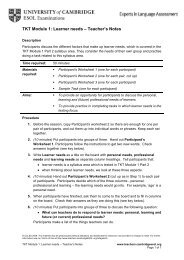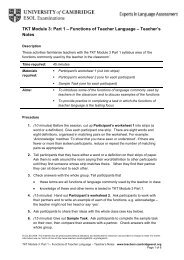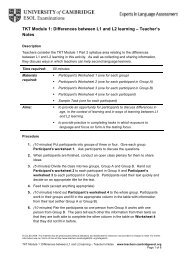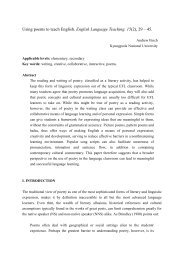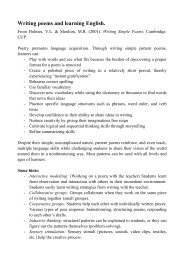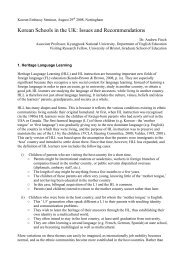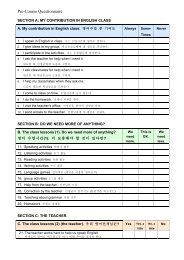Drama in language teaching:
Drama in language teaching:
Drama in language teaching:
- No tags were found...
Create successful ePaper yourself
Turn your PDF publications into a flip-book with our unique Google optimized e-Paper software.
<strong>Drama</strong> <strong>in</strong> <strong>language</strong> teach<strong>in</strong>g:a challenge for creative developmentImag<strong>in</strong>ation is more important than knowledge.Knowledge is limited.Imag<strong>in</strong>ation encircles the world.(Albert E<strong>in</strong>ste<strong>in</strong>)Nelly Zafeiriadou, MA, Ed DTELT State School Advisor, Prefecture of <strong>Drama</strong>nelzafeir@sch.grAbstract:My aim <strong>in</strong> this article is to draw attention to thecase of drama <strong>in</strong> the <strong>language</strong> context as a creativeprocess and a challenge for creativethought. On one hand, by a brief historical reviewof drama teach<strong>in</strong>g I attempt to def<strong>in</strong>e some misconceptionsthat drama may entail and on theother by present<strong>in</strong>g the benefits it offers as a pedagogicaltechnique I aim to alleviate <strong>in</strong>hibitionsseveral <strong>language</strong> educators have as to drama<strong>in</strong>tegration <strong>in</strong> the L2 classroom. I argue for dramaas a teach<strong>in</strong>g technique that fosters not only students'l<strong>in</strong>guistic and emotional development butalso a as a challenge for creative thought and ameans that contributes to what Fontana (1997)called "education for be<strong>in</strong>g,".<strong>Drama</strong> teach<strong>in</strong>g- A historical review.Theatre as a form of Art that communicates feel<strong>in</strong>gsand emotions, thoughts and concerns orig<strong>in</strong>ates s<strong>in</strong>cethe appearance of communal life <strong>in</strong> the history ofhuman civilization.Theatre and drama for educationalpurposes have been def<strong>in</strong>ed <strong>in</strong> many different ways.Methodology books and papers abound <strong>in</strong> terms suchas drama education, theatre education, educationaldrama or creative drama and drama teach<strong>in</strong>g.Traditionally 'theatre' has been taken to refer toperformance whereas 'drama' has referred to the workdesigned for stage representation, the body of writtenplays (Elam, 1980). In the context of drama teach<strong>in</strong>ghowever the terms have been used differently. 'Theatre'was thought to be largely concerned withcommunication between actors and an audience;whereas 'drama' was largely concerned withexperience by the participants, irrespective of anyfunction of communication to an audience (Way, 1967).In the 1980s and 1990s <strong>in</strong> England and many othercountries there was a fairly pronounced divisionbetween writers and practitioners who advocateddifferent approaches to teach<strong>in</strong>g drama. Teachers whotook a theatre approach talked about 'act<strong>in</strong>g','rehearsal' and 'performance' whereas teachers with adrama focus referred more to 'experience' or 'liv<strong>in</strong>gthrough' improvisations (Hornbrook, 1989). In practicethese tended to be more orientations <strong>in</strong> the work ratherthan rigid dist<strong>in</strong>ctions but the differences are crucial <strong>in</strong>understand<strong>in</strong>g the way drama teach<strong>in</strong>g developed;legacies of these approaches are found <strong>in</strong>contemporary practice.(Flem<strong>in</strong>g, 2003)The method of drama teach<strong>in</strong>g which developedfrom the 1950s onwards and embraced more freeforms of dramatic play and improvisation can be seenas a reaction to the stifl<strong>in</strong>g and uncreative approachesat the time which <strong>in</strong>volved children act<strong>in</strong>g out <strong>in</strong> arather formal way the words of others rather thandevelop<strong>in</strong>g ideas of their own (Slade, 1954). It wassuggested that when participants are engaged <strong>in</strong> morespontaneous, improvised work (traditionally called'drama') their level of engagement and feel<strong>in</strong>g will bemore <strong>in</strong>tense and 'genu<strong>in</strong>e' than when they areperform<strong>in</strong>g on stage (traditionally called 'theatre'). Thetheoretical perspectives on drama education were atthat time drawn from writ<strong>in</strong>gs on child play and theHumanistic School of psychology ( Erikson 1963, 1968;Rogers, 1969 ) rather than on the theatre. Theemphasis was on the personal growth of the <strong>in</strong>dividualthrough creative self expression and the the search forpersonal mean<strong>in</strong>g. The <strong>in</strong>fluence of progressivepsychology theorists as George Kelly <strong>in</strong> the 1950s andhis 'personal construct theory'that urges people touncover their own 'constructs' with m<strong>in</strong>imal<strong>in</strong>tervention by the 'therapist' were also apparent <strong>in</strong> theadvocates of drama <strong>in</strong> education. The recent history ofdrama teach<strong>in</strong>g be<strong>in</strong>g described here is represented <strong>in</strong>the follow<strong>in</strong>g diagram by M. Flem<strong>in</strong>g (2003). At the time4 Vol. 23, March 2009 ISSUES
Fairy/Folk Tales and MythsThere are an <strong>in</strong>credible number of books conta<strong>in</strong><strong>in</strong>gcollections of these stories. Some feature tales from aparticular country, religion, or ethnic group, whileothers are grouped by subject (women, animals,nature). When choos<strong>in</strong>g ones to use <strong>in</strong> class, look forsimple plots, dynamic characters, and astraightforward message. Ideally, the tales should betold, rather than read aloud, (besides giv<strong>in</strong>g a bettersense of the dramatic to the listeners, there are also nopictures that you have to show) so learn them well.Children enjoy act<strong>in</strong>g out stories with humorous peopleor situations, and usually are will<strong>in</strong>g to play <strong>in</strong>animateobjects that relate to the plot. Don't be afraid to stretchthe boundaries of the story - add <strong>in</strong> extra familymembers, duplicate protagonists/antagonists, herds ofanimals <strong>in</strong>stead of one so that every child <strong>in</strong> the classhas a role to play. With well-known stories (Little RedRid<strong>in</strong>g Hood, C<strong>in</strong>derella, Jack and the Beanstalk), theclass can use their familiarity with the plot to create newideas, by moderniz<strong>in</strong>g the story, or plac<strong>in</strong>g charactersfrom several different stories <strong>in</strong>to one.PoetryPoems provide a unique opportunity for a dramaclass, as they can be "acted out" <strong>in</strong>stantaneously orafter plann<strong>in</strong>g. Because poetry is often written <strong>in</strong> firstperson, it is easy for the participants to put themselves<strong>in</strong>to the actions or emotions expressed <strong>in</strong> the poem.When select<strong>in</strong>g poetry to use <strong>in</strong> class, look for a varietyof styles, but keep <strong>in</strong> m<strong>in</strong>d that the <strong>language</strong> should bedirect enough for the participants to comprehend. Donot be afraid to use poems that are "silly", most childrendelight <strong>in</strong> the absurd.Children's booksA good children's book can provide enoughactivities for an entire creative drama class period. Youcan create a warm-up, a game, and an art projectbased on the theme of the book <strong>in</strong> addition to dramaexperiences. The most important factor <strong>in</strong> choos<strong>in</strong>gbooks for this purpose is the teacher's or leader's<strong>in</strong>terest - if a particular book gives you many excit<strong>in</strong>gideas, then that is the one you should usePlaysWith groups that respond well to drama activities,putt<strong>in</strong>g on one scene or a short play can be bothenjoyable and reward<strong>in</strong>g. Many students, especiallyadolescents love plann<strong>in</strong>g costumes, sets, props andso on. When full-scale stag<strong>in</strong>g is not feasible, aprepared read<strong>in</strong>g or stag<strong>in</strong>g of a scene <strong>in</strong> front of theclass and with a few props can also be motivat<strong>in</strong>g andreward<strong>in</strong>g. Not neglect<strong>in</strong>g that good play read<strong>in</strong>g is notan easy task even <strong>in</strong> L1 the aim should be work<strong>in</strong>gthrough a whole play <strong>in</strong> such ways that deepenstudents' understand<strong>in</strong>g of the text and the dramaticISSUES Vol. 23, March 2009situation. Modern texts are usually easier to explore <strong>in</strong>the L2 adolescent context for the opportunities theyoffer both of useful <strong>language</strong> transfer and of <strong>in</strong>sights<strong>in</strong>to contemporary, social, political and culturalaspects. Whatever the choice of a play, the underly<strong>in</strong>gteach<strong>in</strong>g pr<strong>in</strong>ciple should be that there are no "wrong"answers - through pretend<strong>in</strong>g, animals can talk, kidscan travel to outer space or the jungle, and the sky canbe green while the grass is blue. Students should befree to explore and experience the texts <strong>in</strong> ways thatfoster their creative th<strong>in</strong>k<strong>in</strong>g and personal growth.EPILOGUEEducat<strong>in</strong>g children and adolescents <strong>in</strong> ways thatfoster creative development is consistent withFontana's (1997) notion of "education for be<strong>in</strong>g," whichmeans offer<strong>in</strong>g our students the right to express theirown feel<strong>in</strong>gs, to give their view of events, to expla<strong>in</strong>themselves, to reflect upon their own behavior, to havetheir fears and their hopes taken seriously, to askquestions, to seek explanations <strong>in</strong> the natural world, tolove and be loved, to have their <strong>in</strong>ner world of dreamsand fantasies and imag<strong>in</strong><strong>in</strong>gs taken seriously, and totake their own engagement with life.In tak<strong>in</strong>g the position that every child has the rightto creative development we need as <strong>language</strong>educators to acknowledge that several challengeshave to be addressed. First, we need to redef<strong>in</strong>ecreative teach<strong>in</strong>g and confront misconceptions aboutcreative th<strong>in</strong>k<strong>in</strong>g. Second, we need to provide studentswith role models of motivation and persistence <strong>in</strong>creative thought, and arrive at more capacious ways ofassess<strong>in</strong>g creative processes and products. Third, weneed to acknowledge that by their very nature,teach<strong>in</strong>g materials are limited. Coursebooks representthe product of careful plann<strong>in</strong>g on the part of textbookwriters; they are not the result of any <strong>in</strong>teractive andcreative process of classroom events and they canhardly address the specific <strong>in</strong>teractive needs and wantsof a given group of learners. Because of theselimitations I subscribe to Prabhu's (1987, p. 94 )position that it is better to treat a text as a pre-text andcourse-books should rather be treated as sourcebooks.The real creative process of <strong>language</strong> learn<strong>in</strong>glies with<strong>in</strong> the nature of <strong>in</strong>teraction amongst thelearners and the teacher whose pr<strong>in</strong>ciple goal shouldbe as Piaget (1974) put it .to create men who are capable of do<strong>in</strong>g new th<strong>in</strong>gs,not simply of repeat<strong>in</strong>g what other generations havedone- men who are creative, <strong>in</strong>ventive and discoverersFor all these reasons and also drawn by my ownprofessional experiences as a <strong>language</strong> educator anda fledgl<strong>in</strong>g researcher I have the view that dramaapproaches offer the teacher unique opportunities tocontribute to the above goal.7
ReferencesBolton, G. (1992) Perspectives on Classroom <strong>Drama</strong>.Hertfordshire: Simon and Schuster.Cobb, E. (1977). The ecology of imag<strong>in</strong>ation. NewYork: Columbia UniversityCollie, J. and Slater, S.( 1987). Literature <strong>in</strong> theLanguage Classroom. Cambridge: CambridgeUniversity Press.Butterfield, A. (1993) <strong>Drama</strong> through <strong>language</strong> throughdrama, Banbury: KembleDougill, J. (1987) <strong>Drama</strong> activities for LanguageLearn<strong>in</strong>g. London: Macmillan.Duffy, B. (1998). Support<strong>in</strong>g creativity and imag<strong>in</strong>ation<strong>in</strong> the early years. Buck<strong>in</strong>gham, UK: Open UniversityPress.Elam, K. (1980) The Semiotics of Theatre and <strong>Drama</strong>.London: Methuen. Repr<strong>in</strong>ted <strong>in</strong> 1988 by Routledge.Erikson, E. H. (1963). Childhood and Society. NewYork: Norton.Erikson, E. H. (1968). Youth and Crisis. New York:NortonFlem<strong>in</strong>g, M. (2003) Start<strong>in</strong>g <strong>Drama</strong> Teach<strong>in</strong>g. London:David Fulton PublishersFlem<strong>in</strong>g, M. (2003b) 'Intercultural Experience and<strong>Drama</strong>' <strong>in</strong> Alred, G, Byram. M. and Flem<strong>in</strong>g, M.(eds.) (2003) Interultural Experience and Education.Clevedon: Multil<strong>in</strong>gual Matters.Gardner, H. 1983. Frames of M<strong>in</strong>d. New York: BasicBooks.Heathcote, 1980 <strong>Drama</strong> as Context NATE papers <strong>in</strong>education: London; NATEHendy, L. and Toon, L. (2001) Support<strong>in</strong>g <strong>Drama</strong> andImag<strong>in</strong>ative Play <strong>in</strong> the Early Years. Philadelphia:Open University Press.Hornbrook, D. (1989) Education and <strong>Drama</strong>tic Art.London: Blackwell Education.Hutts,S., J., Taylor, S., Hutt, C., Christopherson, H.(1989) Play, Exploration and Learn<strong>in</strong>g: A NaturalHistory of Preschool. London: Routledge.K<strong>in</strong>cade, T. (2002). The child’s heart <strong>in</strong> art. AmericanArtist, 66(716), 12.Kumaradivelu, B.( 2003). Beyond Methods:Macrostrategies for Language Teach<strong>in</strong>g.YaleUniversity Press: New Haven and LondoLantolf, J. (2000) Second <strong>language</strong> learn<strong>in</strong>g as amediated process. Language Teach<strong>in</strong>g, 33:79-96Mart<strong>in</strong>dale, C. (2001). Oscillations andanalogies: Thomas Young, MD, FRS,genius. American Psychologist, 56, 342-345.Merleau-Ponty, M. (1962) Phenomenology ofPerception. London: Routledge and Kegan Paul.Piaget, J. (1974). To Understand is to Invent. NewYork:Vik<strong>in</strong>g Press.Prabhu, N. S. (1987) Second Language Pedagogy.Oxford. Oxford University Press.Rogers, C. R. (1969). Freedom to Learn. Columbus,Ohio: Charles Merrill.Shewe, M. and Shaw, P. (eds) (1993) Towards <strong>Drama</strong>As a Method <strong>in</strong> the Foreign Language Classroom.Frankfurt: Peter Lang.Slade, P. (1954) Child <strong>Drama</strong>. London: University ofLondon Press.States, B. (1987) Great Reckon<strong>in</strong>g <strong>in</strong> Little Rooms.Berkeley, University of California Press.Taylor, T. (1997) Theoris<strong>in</strong>g Language. Oxford:Pergamon.Vygotsky, L.(1987) The Collected Works of L. Vygotsky.Volume 1. Th<strong>in</strong>k<strong>in</strong>g and Speak<strong>in</strong>g. New York, NY:Plenum Press.Way, B. (1967) Development Through <strong>Drama</strong> London:Longman.Williams, M. and Burden, R. L. (1997). Psychology forLanguage Teachers. Cambridge: CambridgeUniversity Press.Woolland, B. (1996) The Teach<strong>in</strong>g of <strong>Drama</strong> <strong>in</strong> thePrimary School. London: Longman.APPENDIXSome Web-based Resources for <strong>Drama</strong> <strong>in</strong> EnglishLanguage Teach<strong>in</strong>gArticlesCreat<strong>in</strong>g <strong>Drama</strong> with Poetry: Teach<strong>in</strong>g English as aSecond Language Through <strong>Drama</strong>tization andImprovisationhttp://www.cal.org/ericcll/digest/gaspar01.html"Creat<strong>in</strong>g drama with poetry is an excit<strong>in</strong>g <strong>language</strong>learn<strong>in</strong>g experience. The technique employs a multisensoryapproach to <strong>language</strong> acquisition by <strong>in</strong>volv<strong>in</strong>gsecond <strong>language</strong> learners physically, emotionally, andcognitively <strong>in</strong> the <strong>language</strong> learn<strong>in</strong>g process."Encourag<strong>in</strong>g English Expression through ScriptbasedImprovisationshttp://iteslj.org/Techniques/Berl<strong>in</strong>ger-ScriptImprov.html"Dialogues, scenes and plays that approximate realcommunication provide a dynamic format <strong>in</strong> which<strong>language</strong> skills can be <strong>in</strong>troduced and re<strong>in</strong>forced.Improvisation greatly enhances this approach."Us<strong>in</strong>g <strong>Drama</strong> and Theatre To Promote Literacy8 Vol. 23, March 2009 ISSUES
Development: Some Basic Classroom Applications.ERIC Digest.http://www.ericdigests.org/2004-1/drama.htm"Although numerous researchers have emphasized thetremendous effect drama and theatre can have onchildren's cognitive and affective development as wellas provided abundant resources for teachers, there stillexists a gap between understand<strong>in</strong>g its value andactually apply<strong>in</strong>g it."Lesson Plans, Teach<strong>in</strong>g Tips and Interactive Web SitesCreative <strong>Drama</strong> Lesson Planshttp://www.geocities.com/Broadway/Alley/3765/lessons.htmlLesson plans developed for use <strong>in</strong> a Creative <strong>Drama</strong>Classroom.Child <strong>Drama</strong>http://www.childdrama.com/Classroom ideas, theatre games, plays forperformance, and book list.<strong>Drama</strong> <strong>in</strong> ELThttp://www.drama<strong>in</strong>elt.org/This web site is for all those with an <strong>in</strong>terest <strong>in</strong> the useof drama <strong>in</strong> education and theatre techniques <strong>in</strong><strong>language</strong> teach<strong>in</strong>g and learn<strong>in</strong>g at primary, secondaryand university levels.The <strong>Drama</strong> Teacher's Resource Roomhttp://www3.sk.sympatico.ca/erachi/At the <strong>Drama</strong> Teacher's Resource Room we arestriv<strong>in</strong>g to make it easier for you to encourage creativeand challeng<strong>in</strong>g experiences for students <strong>in</strong> yourdrama classroom.The <strong>Drama</strong>tic Exchangehttp://www.dramex.org/A site where authors post unpublished scripts. Screencarefully for classroom use.http://www.aspa.asn.au/Projects/english/help.htmRole play, historical theater, and drama ideas.Explor<strong>in</strong>g Prejudice <strong>in</strong> Young Adult Literaturethrough <strong>Drama</strong> and Role Playhttp://scholar.lib.vt.edu/ejournals/ALAN/spr<strong>in</strong>g95/Bontempo.htmlYoung adult literature provides rich literary material forexplor<strong>in</strong>g issues and dilemmas of the humanexperience as perceived by the young.National Standards for Theater Educationhttp://www.byu.edu/tma/arts-ed/Information on Improvisation Situations, TheatreGames and <strong>Drama</strong> and Theatre Books.Reader's Theatre Scripts and Playshttp://www.teach<strong>in</strong>gheart.net/readerstheater.htmFor younger learners (primary grades level).Read<strong>in</strong>g Ladyhttp://www.read<strong>in</strong>glady.com/Readers_Theater/Scripts/scripts.html"Reader's Theater" scripts for younger learners(primary grades level).Script Formatt<strong>in</strong>ghttp://www.humboldt.edu/~jmf2/floss/323rt.script.example.htmlAn example of a tried and true format for creat<strong>in</strong>gscripts from exist<strong>in</strong>g stories.TEFL.NET ESL Lesson Plans, Improvisationshttp://www.tefl.net/lessonplans/improvisations.htm"Improvisations are not role-plays or simulations(although many of them can be adapted as such). Theobjective here is total spontaneity and improvisation."The Virtual <strong>Drama</strong> Studiohttp://www.thevirtualdramastudio.co.uk/<strong>Drama</strong>tic Storytell<strong>in</strong>g <strong>in</strong> the English ClassroomNelly Zafeiriadou - bio data notesNelly Zafeiriadou holds a BA <strong>in</strong> English Language and Literature from the Aristotle University of Thessaloniki andan MA <strong>in</strong> Applied L<strong>in</strong>guistics and ELT from the University of East Anglia. She's currently pursu<strong>in</strong>g EducationDoctoral studies at the University of Exeter. She has been the Chair person of the Teachers of English Union ofThrace and Eastern Macedonia association, the BRIDGES journal Manag<strong>in</strong>g Editor and a KPG multiplier for thearea of Thrace. She presented papers at national and <strong>in</strong>ternational conferences and published articles <strong>in</strong> theareas of educational psychology, literature and culture <strong>in</strong> <strong>language</strong> education, authenticity and creativity, criticalissues <strong>in</strong> TESOL and teacher education. S<strong>in</strong>ce 2007 she has been serv<strong>in</strong>g at the post of an ELT State SchoolAdvisor <strong>in</strong> <strong>Drama</strong> Prefecture, Eastern Macedonia.ISSUES Vol. 23, March 20099



